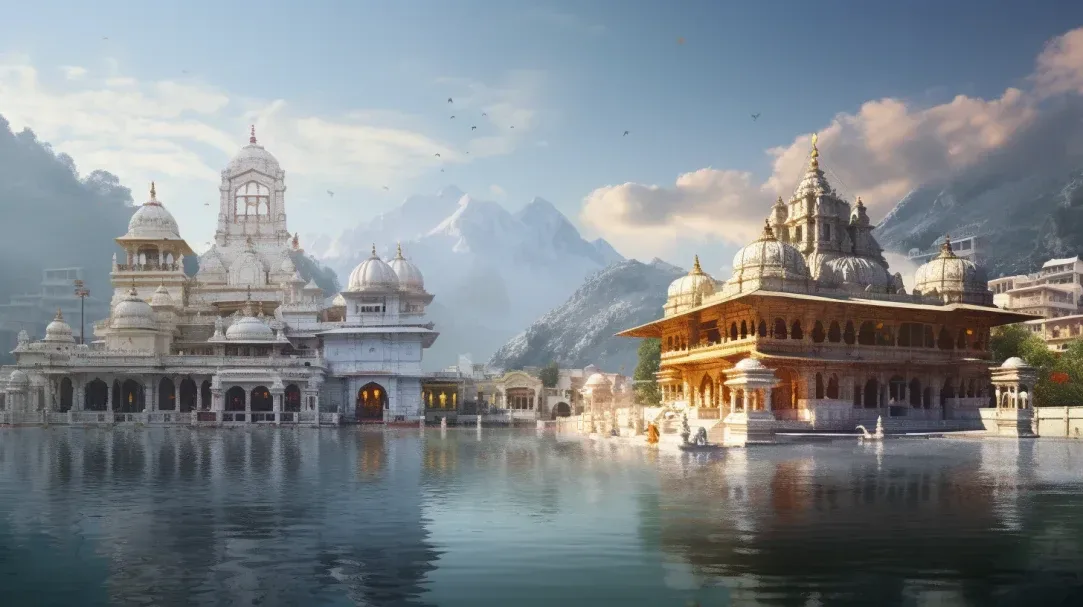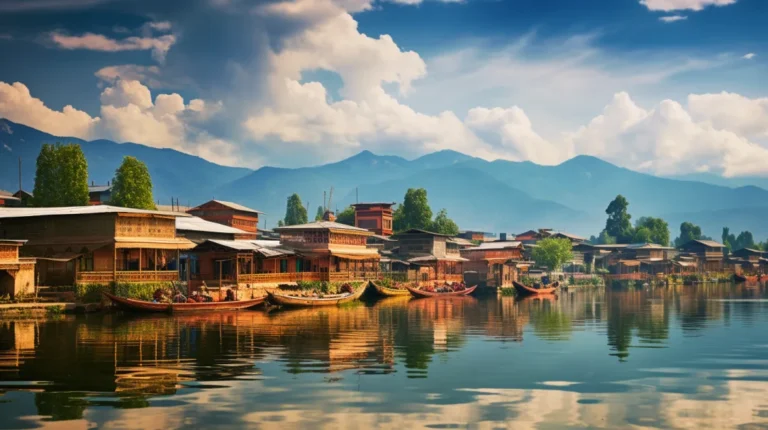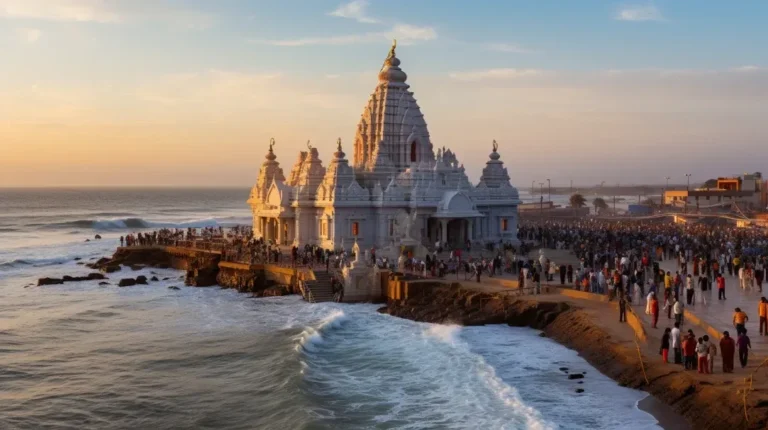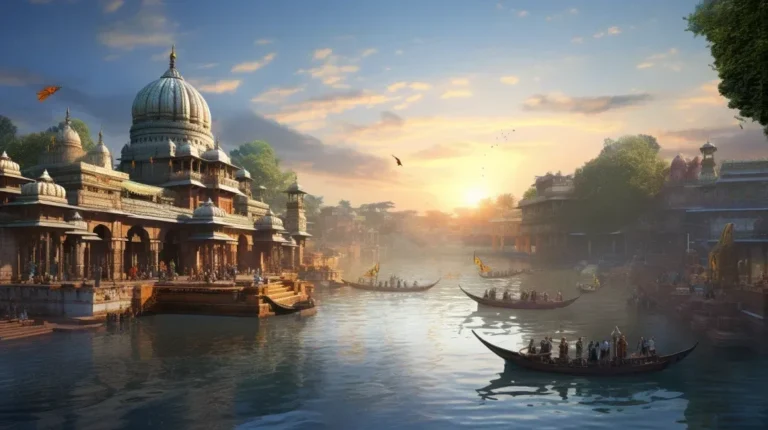Divine Journeys: Exploring India’s Most Sacred Pilgrimage Sites
Divine Journeys: Exploring India’s Most Sacred Pilgrimage Sites takes readers on a captivating exploration of some of India’s holiest destinations. This insightful book unveils the rich tapestry of spiritual experiences that await those who embark on these divine expeditions.
From the tranquil banks of the Sacred Ganges River to the awe-inspiring temples of Varanasi, each chapter delves into the history, significance, and rituals that make these sites so revered. The pilgrimage sites covered include the spiritual retreat of Haridwar, the enigmatic caves of Amarnath, the Buddhist monastery of Bodh Gaya, the Jain temples of Palitana, the divine mountains of Vaishno Devi, and the ancient temples of Ayodhya.
Written in a professional and accessible style, Divine Journeys offers a comprehensive understanding of these sacred places, allowing readers to embark on their own spiritual quests with a deeper appreciation and knowledge.
Key Takeaways
- The Ganges River is considered the embodiment of the goddess Ganga and is revered for its purity and spiritual cleansing properties.
- Varanasi and Rishikesh are home to iconic temples and ashrams, providing a serene environment for spiritual seekers to connect with their inner selves.
- Haridwar attracts pilgrims seeking divine connection and purification, with the Ganga Aarti ritual creating an enchanting atmosphere.
- The Amarnath caves in Jammu and Kashmir hold immense spiritual importance and attract devotees with their mystical allure and icy stalagmites.
The Sacred Ganges River
The Sacred Ganges River holds immense spiritual significance in India, attracting pilgrims from all over the world. Flowing through the heart of the country, this sacred river is believed to be the physical embodiment of the goddess Ganga.
The Ganges is revered as a source of purity and spiritual cleansing, with its waters said to possess healing properties. Pilgrims come to the riverbanks to perform rituals, offer prayers, and immerse themselves in its holy waters to seek blessings and absolution from sins.
The Ganges is lined with numerous ghats, or steps leading down to the water, where devotees gather for religious ceremonies and cremations. The sight of devotees bathing and performing religious rites along the banks of the Ganges is a deeply moving and spiritual experience, immersing visitors in the rich cultural and religious heritage of India.
The Majestic Temples of Varanasi
Varanasi, a city in India known for its spiritual significance, is home to some of the most majestic temples in the country. These temples are not only architectural marvels but also hold immense religious and cultural importance.
Here are three notable temples in Varanasi:
- Kashi Vishwanath Temple: Dedicated to Lord Shiva, this temple is one of the holiest sites for Hindus. It is believed that a visit to this temple can grant salvation and liberation from the cycle of life and death.
- Sankat Mochan Hanuman Temple: This temple is dedicated to Lord Hanuman, the monkey god. Devotees flock to this temple to seek blessings and protection from Lord Hanuman, who is renowned for his strength and devotion.
- Durga Temple: This temple is dedicated to Goddess Durga, the divine feminine power. It is a popular pilgrimage site and is known for its grandeur and intricate architecture.
These majestic temples in Varanasi not only showcase the rich cultural heritage of India but also provide a serene environment for spiritual seekers to connect with their inner selves and experience divine bliss.
The Holy City of Rishikesh
Nestled in the foothills of the Himalayas, Rishikesh beckons spiritual seekers with its tranquil ambiance and sacred offerings. This holy city, situated on the banks of the Ganges River, is renowned as the “Yoga Capital of the World” and holds immense spiritual significance for Hindus. Rishikesh is home to numerous ashrams, where seekers can immerse themselves in meditation and yoga practices under the guidance of experienced gurus. The city is also famous for its suspension bridge, Ram Jhula, and the iconic Laxman Jhula, which offer breathtaking views of the river and surrounding mountains. To provide a glimpse of the diverse attractions in Rishikesh, here is a table showcasing some notable places to visit:
| Place | Description |
|---|---|
| Triveni Ghat | A sacred bathing ghat on the Ganges |
| Parmarth Niketan | Renowned ashram for spiritual retreat |
| Neelkanth Mahadev | Ancient temple dedicated to Lord Shiva |
| Beatles Ashram | Former ashram visited by The Beatles |
Rishikesh invites visitors to embark on a spiritual journey, where they can find solace, inner peace, and connect with their higher selves amidst the serenity of the Himalayan landscape.
The Spiritual Retreat of Haridwar
Located on the banks of the sacred Ganges River, Haridwar serves as a spiritual retreat for pilgrims seeking divine connection and purification. This ancient city, with its rich spiritual heritage and sacred rituals, has attracted seekers of truth and enlightenment for centuries.
Here are three aspects that make Haridwar a unique and profound destination for spiritual seekers:
- Ganga Aarti: Every evening, as dusk descends, Haridwar comes alive with the mesmerizing sight of the Ganga Aarti. Devotees gather at the ghats, offering prayers and lighting oil lamps, while priests perform intricate rituals. The divine energy and the ethereal atmosphere created by this ritual are truly enchanting.
- Holy Baths: The ghats of Haridwar are renowned for their sacredness. Pilgrims immerse themselves in the holy waters of the Ganges River, believing that it washes away their sins and purifies their souls. The experience of taking a dip in the river amidst chanting and prayers is deeply transformative.
- Temples and Ashrams: Haridwar is home to numerous ancient temples and ashrams that offer spiritual solace and guidance. From the famous Mansa Devi Temple to the serene Sapt Rishi Ashram, each place holds its own charm and significance, providing pilgrims with the opportunity to connect with the divine.
As we delve further into the spiritual journey, let us now explore the enigmatic caves of Amarnath.
The Enigmatic Caves of Amarnath
The Amarnath caves, a revered pilgrimage site in India, attract thousands of devotees each year with their mystical allure and sacred significance. Nestled in the Himalayan region of Jammu and Kashmir, these enigmatic caves are believed to be the abode of Lord Shiva, the Hindu deity of destruction and creation.
The journey to the Amarnath caves is not for the faint-hearted, as devotees undertake a treacherous trek through rugged terrain and freezing temperatures. However, the arduous path is rewarded with a sight that transcends the physical realm – an ice lingam, a symbol of Lord Shiva, which forms naturally inside the cave. This miraculous phenomenon is considered an embodiment of divine energy and is a spiritual experience unlike any other.
The Amarnath caves stand as a testament to the unwavering faith and devotion of pilgrims who seek solace and enlightenment in the presence of the divine.
As we delve deeper into the realm of sacred pilgrimage sites, let us now transport ourselves to the serene temples of Pushkar.
The Serene Temples of Pushkar
The temples of Pushkar exude serenity, offering devotees a tranquil space for spiritual reflection and worship. Nestled in the heart of Rajasthan, Pushkar is home to over 500 temples, each with its own unique charm and significance.
Here are three notable temples that draw pilgrims from all corners of the world:
- Brahma Temple: Dedicated to Lord Brahma, the creator of the universe, this temple is one of the very few in the world that is dedicated to this deity. The serene atmosphere and the sacred Pushkar Lake nearby make it a must-visit for devotees seeking spiritual solace.
- Savitri Temple: Perched atop a hill, this temple is dedicated to Goddess Savitri, the wife of Lord Brahma. The panoramic view of the town and the surrounding desert from the temple is awe-inspiring, offering a sense of serenity and peace.
- Varaha Temple: This ancient temple is dedicated to Lord Varaha, the boar incarnation of Lord Vishnu. The intricate carvings and architectural brilliance of the temple mesmerize visitors, while the divine aura fills the air with a sense of tranquility and reverence.
Visiting the serene temples of Pushkar is a journey of the soul, where one can find solace, inner peace, and a deeper connection with the divine.
The Sacred City of Mathura
Nestled on the banks of the Yamuna River, the sacred city of Mathura holds immense significance in Hindu mythology. It is believed to be the birthplace of Lord Krishna, an incarnation of Lord Vishnu.
The city is adorned with numerous temples and is a hub of vibrant festivals and rituals that attract thousands of devotees each year.
Krishna’s Birthplace Significance
Krishna’s birthplace holds immense significance in the sacred city of Mathura, attracting pilgrims from all over India. This ancient city, located in the northern state of Uttar Pradesh, is believed to be the birthplace of Lord Krishna, a revered deity in Hinduism. Here are three reasons why Krishna’s birthplace is so revered:
- Mythological importance: According to Hindu scriptures, Mathura is the place where Lord Krishna was born and spent his early childhood. The city is filled with temples and sacred sites associated with the life and legends of Lord Krishna.
- Spiritual significance: Mathura is considered a highly auspicious place for spiritual seekers and devotees of Lord Krishna. Pilgrims visit to seek blessings, offer prayers, and immerse themselves in the divine atmosphere of Krishna’s birthplace.
- Cultural heritage: Mathura is not only a pilgrimage site but also a center of cultural heritage. The city showcases the rich traditions, art, and architecture of ancient India, making it a must-visit destination for those interested in the country’s cultural legacy.
Transition: Now, let’s delve into the vibrant festivals and rituals that take place in Mathura, further enriching the spiritual experience for the pilgrims.
Festivals and Rituals
Celebrated with fervor and devotion, the festivals and rituals in the sacred city of Mathura offer a vibrant and immersive experience for pilgrims. Mathura, known as the birthplace of Lord Krishna, is a city steeped in spiritual significance. Throughout the year, various festivals and rituals take place, attracting devotees from all over the world. One of the most famous festivals is Janmashtami, which commemorates Lord Krishna’s birth. The city comes alive with colorful decorations, music, and dance performances. Another significant event is Holi, the festival of colors, where people joyfully throw vibrant powders at each other, symbolizing the triumph of good over evil. The table below showcases some of the key festivals and rituals celebrated in Mathura:
| Festival/Ritual | Significance |
|---|---|
| Janmashtami | Celebrates Lord Krishna’s birth |
| Holi | Festival of colors |
| Radha Ashtami | Honors the divine love of Radha and Krishna |
| Govardhan Puja | Commemorates the lifting of Govardhan Hill by Lord Krishna |
| Rang Panchami | Celebrates the playfulness of Lord Krishna |
These festivals and rituals not only deepen the spiritual connection of the pilgrims but also foster a sense of unity and joy within the community. Participating in these sacred celebrations allows individuals to experience the rich cultural heritage and the divine essence that permeates the sacred city of Mathura.
The Buddhist Monastery of Bodh Gaya
Located in the state of Bihar, the Buddhist Monastery of Bodh Gaya stands as a revered site where Siddhartha Gautama attained enlightenment. This sacred place holds immense spiritual significance for Buddhists around the world.
The monastery is surrounded by lush greenery and exudes a sense of tranquility and peace. As you enter the monastery, you are greeted by the majestic Bodhi tree, said to be a direct descendant of the original tree under which Gautama Buddha meditated.
The monastery complex consists of several structures, each holding its own significance. The main temple, known as the Mahabodhi Temple, is adorned with intricate carvings and houses a golden statue of Buddha.
The monastery also has a meditation hall where devotees and visitors can practice mindfulness and experience inner peace. Visiting the Buddhist Monastery of Bodh Gaya is a profound experience that allows individuals to connect with the teachings and wisdom of the Buddha.
The Jain Temples of Palitana
The Jain Temples of Palitana, a collection of over 900 temples, hold great reverence among followers of Jainism and are known for their exquisite architecture and spiritual significance. Located on Shatrunjaya Hill in the Bhavnagar district of Gujarat, India, this sacred pilgrimage site is considered the holiest place in Jainism. The temples, built over a span of 900 years, showcase the rich heritage and artistic brilliance of Jain architecture. Each temple is intricately carved with delicate designs and adorned with sculptures depicting various Jain deities. The climb up the 3,800 steps to reach the temples is not only a physical journey but also a spiritual one, as pilgrims meditate and recite prayers along the way. The serene atmosphere and breathtaking views from the hilltop add to the mystical experience of visiting these sacred temples.
|  |  |  |
|  |  |  |
|  |  |  |
The Divine Mountains of Vaishno Devi
Nestled amidst the majestic Himalayas, the divine mountains of Vaishno Devi beckon pilgrims from all corners of the world.
As they embark on their arduous journey, pilgrims are not only seeking a physical ascent, but also a spiritual elevation.
The pilgrimage to Vaishno Devi is a sacred experience filled with profound rituals and deep-rooted spiritual significance. Its history is intertwined with tales of devotion and divine intervention.
Pilgrim Experiences and Rituals
A journey to the sacred mountains of Vaishno Devi offers pilgrims a profound and transformative experience. Surrounded by the majestic Himalayas, these divine peaks instill a sense of awe and reverence in the hearts of devotees.
As pilgrims embark on the arduous trek to the shrine, they immerse themselves in a series of rituals that deepen their spiritual connection and bring them closer to the divine. Here are three key aspects of the pilgrim experience at Vaishno Devi:
- The Trek: The journey to the shrine is not just a physical challenge but a spiritual quest. As pilgrims climb the steep slopes, their determination and devotion are tested, and they learn the value of perseverance and faith.
- Bhakti (Devotion): The pilgrimage to Vaishno Devi is marked by an overwhelming sense of devotion. Pilgrims chant hymns and prayers, expressing their love and devotion for the Goddess. The atmosphere is filled with a palpable energy, as devotees surrender themselves completely to the divine presence.
- Darshan (Divine Vision): The ultimate goal of the pilgrimage is to have darshan, a sacred glimpse of the Goddess. As pilgrims stand in line, patiently waiting for their turn, anticipation and excitement fill the air. When they finally come face to face with the deity, their hearts overflow with joy and gratitude.
The pilgrimage to Vaishno Devi is not just a physical journey; it is a spiritual odyssey that leaves pilgrims transformed and blessed by the divine.
Spiritual Significance and History
Located amidst the majestic Himalayas, the divine mountains of Vaishno Devi hold immense spiritual significance and boast a rich history. This sacred pilgrimage site is believed to be the abode of the Hindu goddess Vaishno Devi, who is considered the embodiment of divine power.
The journey to this holy site is considered a transformative experience for devotees who seek spiritual enlightenment and blessings. The mountains themselves are revered as manifestations of the goddess, with each peak representing a different aspect of her divine power.
The history of Vaishno Devi dates back centuries, with mentions in ancient scriptures and legends. It is believed that the site has been a place of worship since time immemorial, attracting millions of pilgrims from all over the world.
The spiritual significance and historical importance of the divine mountains of Vaishno Devi make it a truly awe-inspiring destination for seekers of spirituality.
The Ancient Temples of Ayodhya
Ayodhya, home to ancient temples, is a revered pilgrimage site in India. This sacred city holds immense spiritual significance, attracting devotees from all over the world. The ancient temples in Ayodhya are steeped in history and provide a glimpse into the rich cultural heritage of the region.
Here are three notable temples that pilgrims often visit:
- Ram Janmabhoomi Temple: This temple is believed to be the birthplace of Lord Rama, an incarnation of Lord Vishnu. It is a site of great importance for Hindus and holds a special place in their hearts.
- Hanuman Garhi: Dedicated to Lord Hanuman, the monkey god, this temple is situated on a hill and offers panoramic views of Ayodhya. Devotees come here to seek blessings and experience a sense of peace and tranquility.
- Kanak Bhavan Temple: This temple is dedicated to Lord Rama and his wife, Goddess Sita. It is believed to be the palace where Lord Rama and Goddess Sita resided during their time in Ayodhya.
Visiting these ancient temples in Ayodhya allows devotees to immerse themselves in the divine energy and experience spiritual bliss.
Frequently Asked Questions
How Can I Arrange a Guided Tour to Visit All These Sacred Pilgrimage Sites in India?
To arrange a guided tour to visit India’s sacred pilgrimage sites, consult with reputable travel agencies or tour operators specializing in religious tourism. They can provide tailored itineraries, experienced guides, and necessary arrangements to ensure a meaningful and spiritual journey.
What Are Some Common Rituals or Practices Performed at These Sacred Sites?
Common rituals and practices at India’s sacred pilgrimage sites include ablution in holy rivers, circumambulation of temples, offering of prayers, lighting of incense and lamps, participation in religious ceremonies, and seeking blessings from deities.
Are There Any Specific Clothing or Attire Requirements for Visiting These Pilgrimage Sites?
When visiting sacred pilgrimage sites in India, it is important to dress modestly and respectfully. This often includes wearing traditional attire such as sarees, dhotis, or kurta-pajamas. It is a sign of reverence and shows your understanding of the spiritual significance of the place.
Are There Any Restrictions or Guidelines for Photography or Videography at These Sacred Sites?
Photography and videography at sacred pilgrimage sites in India may have restrictions or guidelines. These measures ensure respect for the sanctity of the place and the privacy of worshippers. Visitors are advised to check with the authorities or follow any signage provided.
Are These Pilgrimage Sites Accessible for People With Disabilities or Limited Mobility?
These sacred pilgrimage sites in India offer accessibility options for people with disabilities or limited mobility. They strive to ensure that all individuals can experience the spiritual journey and seek divine blessings.
Conclusion
In conclusion, India’s sacred pilgrimage sites offer a profound spiritual experience, inviting devotees to embark on divine journeys that transcend the physical realm. From the sacred Ganges River to the ancient temples of Ayodhya, each destination holds its own unique charm and significance.
These sacred sites serve as a sanctuary for seekers of enlightenment and provide a glimpse into the rich tapestry of India’s spiritual heritage. Embarking on these pilgrimages is akin to embarking on a transformative odyssey, where one can truly find solace and connect with the divine.
As the saying goes, ‘The journey of a thousand miles begins with a single step.’ ‘The journey of a thousand miles begins with a single step, and in the case of these spiritual pilgrimages, that single step can lead to a lifetime of spiritual growth and enlightenment.’







